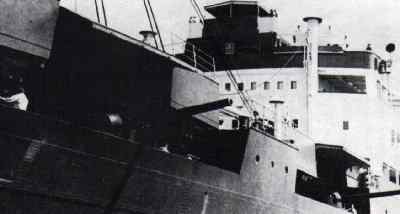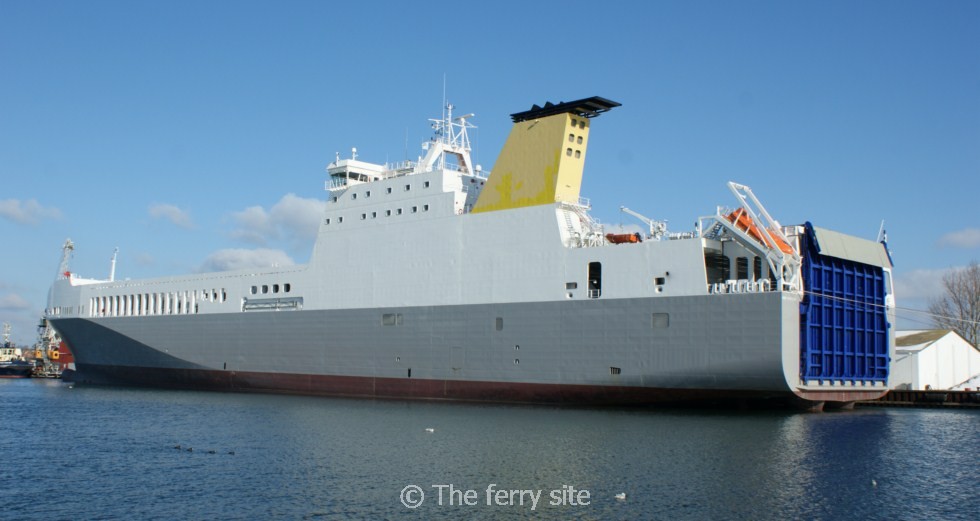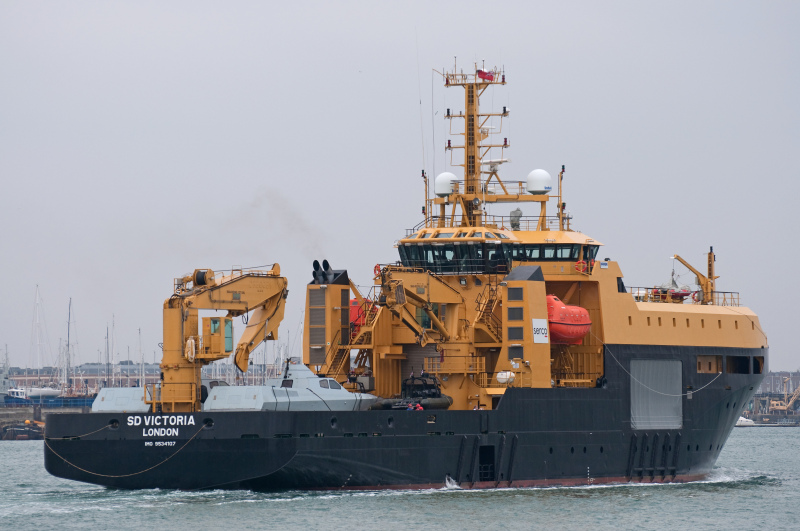By Chuck Hill
Since before recorded history, merchant vessels have been adapted for offensive purposes by navies, pirates, and privateers to destroy enemy commerce or to launch attacks ashore. Frequently they employed disguise and deception. The UK employed Ships Taken Up From Trade (STUFT) during the 1982 Falklands War, the Malaysian Navy has converted two container ships into pirate hunters, and the US Navy has leased ships to support special operations, but I think the last time they were used to attack commerce was WWII. By the end 1943, it appeared that technology, primarily in the form of reliable radios, plus robust challenge-and-reply procedures, a comprehensive naval control of shipping organization, and a seemingly impervious blockade of the German coast, had made this type of warfare very dangerous, but new technology may now be working in favor of using converted merchant ships as clandestine warships.
The German Experience
During World Wars I and II, the German Navy achieved considerable success using armed merchant ships as clandestine merchant raiders. At small cost they sank or captured a large number of allied merchant vessels, tied down a number of warships searching for the raiders, and even managed to sink allied warships.
In World War I, three raiders, Wolf, Moewe, and Seeadler (a full rigged sailing ship), sank or captured 78 ships totaling 323,644 tons. In addition to the merchant ships they captured or sank directly, merchant raiders proved effective mine layers. One victim of a mine laid by the raider Moewe was the pre-dreadnought battleship EdwardVII, sunk on 6 January, 1915.
In World War II nine German Merchant raiders, Atlantis, Komet, Kormoran, Michel, Orion, Pinguin, Stier, Thor, and Widder, sank or captured 129 ships, totaling 800,661 tons. While this pales in comparison to the sinkings by U-boats, they were far more effective than the regular navy surface raiders, including the vaunted pocket battleships, heavy cruisers, and battleships Scharnhorst and Gneisenau, that managed to sink or captured only 59, totaling 232,633 tons. The merchant raider Kormoran even managed to torpedo and sink the light cruiser HMAS Sidney, before the Kormoran herself was also sunk.
Typically, the raiders of WWII were equipped with six obsolescent 5.9″ guns and large numbers of torpedoes to allow ships to be sunk rapidly. Most were also equipped with aircraft and some with torpedo boats. They were also equipped to change their appearance while underway.
Several of their voyages were extraordinarily long. Michel’s first voyage was 346 days. Orion’s was 510 days. Thor was away 329 days and managed to sink HMS Voltaire, an armed merchant cruiser. Pinguin for 357 days. Komet for 512 days. Kormoran for 350 days before her fatal encounter with HMAS Sydney. The ships were refueled and rearmed by supporting vessels that also took their prisoners. Raiders were also used to resupply submarines.
Perhaps surprisingly, none of these WWII raiders were underway when the war began, when they might have been most effective. They were sortied in two waves in 1940 and 1942.
End of the Merchant Raider
Despite their successes, by the time the last German raider at sea was sunk on 7 September, 1943, by a US submarine shortly after it had sortied from Japan, it had become impossible for ships to sortie from Germany and make it to open sea. Komet and a tenth raider were both sunk attempting to do so. Three of the nine, Atlantis, Pinguin, and Kormoran, were sunk in distant seas by British cruisers. One, Stier, was sunk by the Naval Armed Guard on the Liberty ship Stephen Hopkins. One was destroyed by a nearby explosion while moored in Yokohama. Two, Orion and Widder, survived their career as raiders long enough to return to Germany and be repurposed.
Rebirth–Weapons and Sensors, Old and New
Technological changes in the form of containerized cruise missiles, satellites and UAVs and other Unmanned Vehicles may have made the merchant cruiser once again a viable option.
Cruise missiles mean that the raider no longer needs to come with visible range of the their victim. With sufficient range and use of way points, the shooter can be over 100 miles from its victim and the missile can come from any direction, not necessarily from the direction of the raider. Plus they can now attack land targets as well as ships. The US has begun to think seriously about the threat of a cruise missile attack on the US and innocent looking container ships are a possible source.
UAVs can provide over the horizon targeting and are likely to be undetected by the target.
Satellites may help or hurt potential raiders. If they have the support of satellites, it may help them find their pray. If the defenders are sufficiently sophisticated (and they are looking in the right place) they may be able to recognize a missile launch as the first step in finding, fixing and destroying the raider.
Similarly the Automatic Identification System may help the raider or the defender. It may help the raider find targets, but it may also help the defender react more swiftly to an attack or help him identify the raider from among all the other ships in the area. There is always the possibility the information may be bogus. Unmanned Surface Vessels might be used to create false targets. We might want to plan for a system of encrypted information for contingencies. Limiting use of the systems is an option that may require careful consideration.
Mines are still potentially effective. The large carrying capacity of cargo ships means they could potentially lay large mine fields. A raider could knowing a war will start soon might lay a large field to be activated when hostilities begin. If hostilities have already begun, the raider is unlikely approach a port closely enough to lay the mines itself, but mobile mines already exist, and Unmanned Underwater Vehicles or even simple semi-submersible unmanned vessels that can lay an minefield should be relatively easy technology.
China, Perpetrator or Target
From an American point of view, China with its huge merchant fleet and large inventory of cruise missile may appear a possible user of Merchant Raiders, but their large merchant fleet and need to import may also make them vulnerable to this this type of warfare if employed by weaker nations.
We know China has a Naval Militia. that will allow them to rapidly increase the size of their naval force. China has recently said it would require its ship builders to incorporate features that would make them usable for military purposes in wartime. These requirements are to be applied to five categories of vessels – container, roll-on/roll-off, multipurpose, bulk carrier and break bulk. What these additional features are to be, is not clear. This could mean upgraded communications, either external or internal. It could mean improved survivability, greater speed, or foundations for weapons upgrades. They may only be thinking of using these ships to support amphibious operations, but these improvements may also make a large number of ships potential merchant raiders.
China’s large merchant fleet and need to import raw materials may make her vulnerable to Guerre d’Course. In the kind of low intensity conflict we have seen between China and her neighbors, it has seemed China has had all the advantages, but if they are pushed too far, China’s neighbors might see this form of warfare as a way to push back.
Non-State Actors
There is also the possibility of terrorist organizations attempting something similar, but they are more likely to attack highly visible targets of a symbolic nature, such as port facilities or major warships. Cruise missile could of course be used to attack major landmarks. They may also be less interested in living to fight another day.
Conclusion: I don’t think we have seen the end of offensive use of Merchant vessels.
Sources:
- Marauders of the Sea, German Armed Merchant Raiders During World War I
- Marauders of the Sea, German Armed Merchant Raiders During World War 2
- Conway’s All the World’s Fighting Ships, 1922-1946
Addendum:
Some photos of vessels that are being used for military purposes:
MSC has chartered the MV Craigside to support SOCOM requirements. It is undergoing conversion in Mobile.
SD Victoria lifts boats and supports crews for UK Special Forces (SBS and SAS).
Malaysian auxiliary warship Bunga Mas Lima
Chuck retired from the Coast Guard after 22 years service. Assignments included four ships, Rescue Coordination Center New Orleans, CG HQ, Fleet Training Group San Diego, Naval War College, and Maritime Defense Zone Pacific/Pacific Area Ops/Readiness/Plans. Along the way he became the first Coast Guard officer to complete the Tactical Action Officer (TAO) course and also completed the Naval Control of Shipping course. He has had a life-long interest in naval ships and history.





It’s a lot more difficult for a merchant raider to operate for extended periods at sea in the 2nd decade of the 21st century. ASCM’s are a much more expensive weapon to kill merchants with than the deck guns used by the WW1 and WW2 variety. Given the present globalized and connected world, no merchant raider will long escape detection and identification. Such ships, operating in disguise, could be a local or regional force multiplier in a surprise attack at the outset of a conflict, but moving forward into a conventional naval conflict, they would likely be destroyed by regular military units in short order.
We will have to disagree about how easy it will be to track them down, but sounds like you agree that they might be used to attack PrePositioned ships, fleet train, and even regular fleet units at the beginning of a conflict.
seems to me that the greater threat is the possibility that a weaponized container could simply be added to the deck load of a US-bound container ship. some bribery or other manipulation would be required to ensure it remained in unobstructed firing position, but that could be accomplished. then those wishing the US harm could target and operate the weapons remotely, via satellite link. the vessel’s Master might be completely innocent. I’ve made this same argument for many years in the context of the WMD threat. people seem to assume that a vessel-borne WMD would be carried by a knowing, dedicated suicide crew. I find it much more likely that it would simply be contracted for shipping to a destination in the US, and the Master and crew would have no knowledge of what they were carrying.
I was beginning to wonder when someone would think of the potential that new weapons offer to potential merchant raiders. The containerised cruise missile is one, but also think about the potential of modern long- range wire-guided torpedoes and the newer long-range torpedoes that will pop up to check their navigation with GPS. Both could not only be useful against ships targeted by a UAV (shades of the autogyro used by some U-boats!), but against ships alongside or in anchorages, particularly given an SF operator or two ashore with eyes on a port.
The most tempting use would be by a country with a large merchant fleet as part of a first strike on opening a war, although one could also imagine a country using unacknowledged raiders to harass another.
The most recent example that I can think of was the Libyan mining of the Red Sea approaches to the Suez Canal in 1984, which was done using a cargo ship.
You also mention miniature submarines in passing. Considering the damage that they managed to inflict during WW II for in most cases very little effort – and the indirect impact of their potential presence – they could be a real problem in the future: Particularly if delivered to the area of the target clandestinely using a merchant vessel, and armed with long-range torpedoes.
And do not forget the Italian attack divers operating against Gibraltar from a beached cargo ship during WW II. Again, modern technology suggests some interesting potential there.
Good article that should open and focus some minds.
Italian frog men actually penetrated Alexandria harbor and sank a British battleship.
In fact they crippled two battleships and damaged a destroyer and a tanker. The only problem from the Axis point of view was that both of the battleships settled on the bottom in very shallow water, so air photos showed them apparently intact. Had the Germans and Italians known both were out of action, they might have acted quite differently in the Mediterranean at the time.
An outstand strategic operation that failed – at the strategic level – only by the whisker of not understanding that the ships were sitting on the bottom.
Let me echo the recommendation made above: “Good article that should open and focus some minds”.
I will not go into the detail, suffice to say that these ‘maritime Trojans’ provide options to quickly gain a sufficiently strong foothold in countries bordering key maritime choke points. The outcome of such an action (or rather the decision to commit to surprise action) is not just speculation, but the result of a careful analyses of opposing maritime force dispositions, in country support, own reinforcement options, ability to rapidly and decisively respond against the ‘trojans’ (and accept escalation in doing so), et cetera.
An interesting article, armed merchant ships certainly have some attractions, at least from a historical point of view. The heroic efforts of HMS Jervis Bay could also have been mentioned.
The Trojan horse theory has been circulating since 9/11, but the world is still waiting for such terrorist attack. Maybe the ISPS code is working?!
http://www.foxnews.com/story/2004/12/20/ap-lng-tanker-attack-would-be-devastating.html
Osprey books has a couple of good books on these commerce raiders.
I personally believe commerce raiders are a great first strike option, one which we need be careful about being used against the U.S.
Returning to miniature submarines, which could quite easily be carried to the scene by an innocent-appearing merchant vessel, particularly as part of a first strike operation:
– Consider the impact of the attack at Madagascar that damaged an RN battleship and sank a tanker, which changed the strategic situation in the western Indian Ocean for a time.
– Consider the sinking of Tirpitz, which removed a key threat to the arctic convoys.
Now factor in modern miniature boats, perhaps with a fuel cell AIP propulsion system, with modern navigation aids and with modern long-range torpedoes.
Concept still alive. http://www.thedrive.com/the-war-zone/11723/israel-just-launched-a-containerized-ballistic-missile-from-the-deck-of-a-ship
But is it legal?
Conversion of Merchant Ships into War Ships (Hague VII); October 18, 1907
http://avalon.law.yale.edu/20th_century/hague07.asp